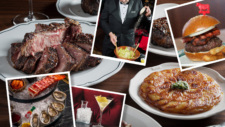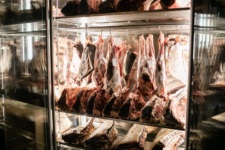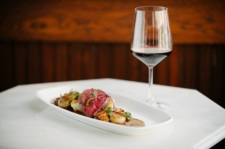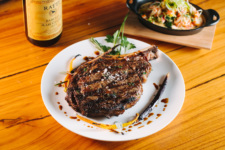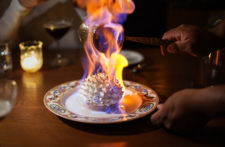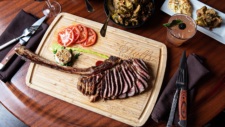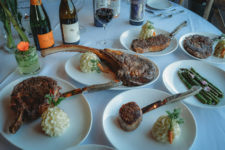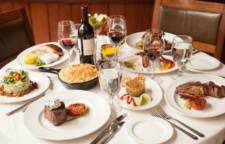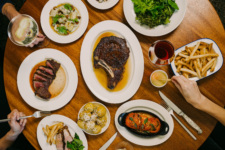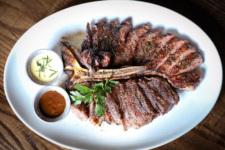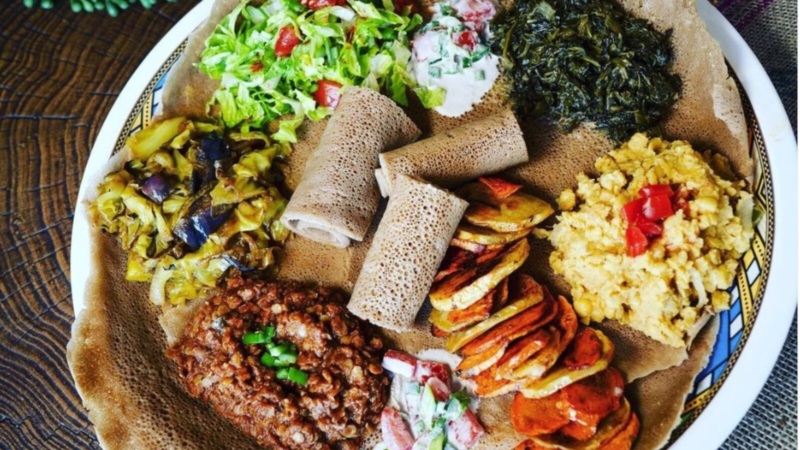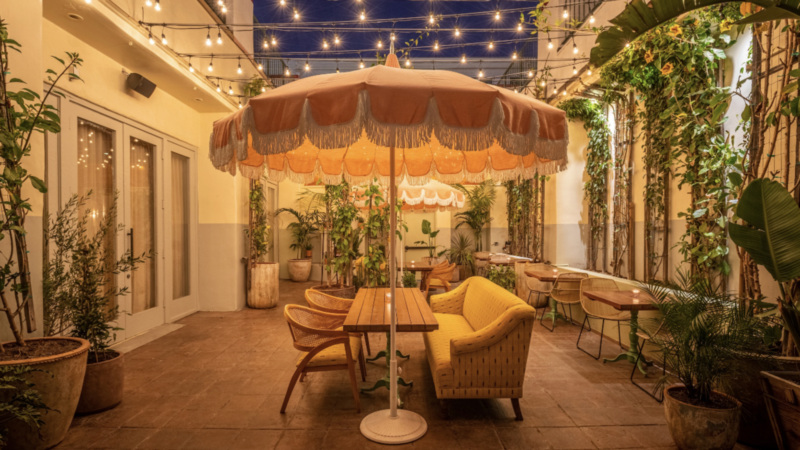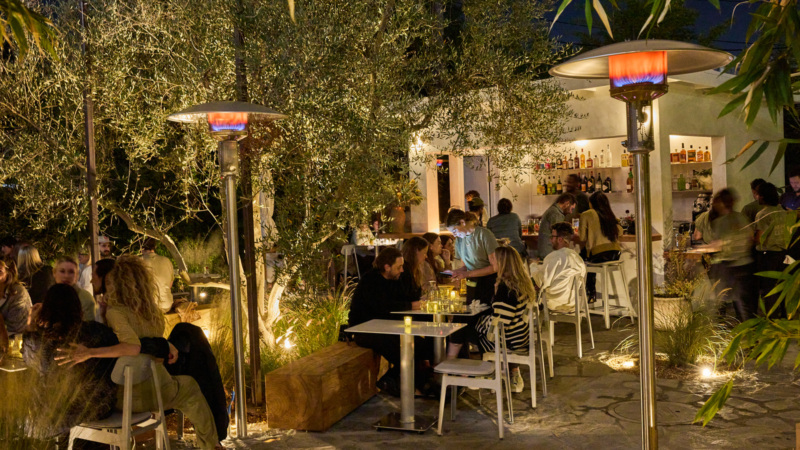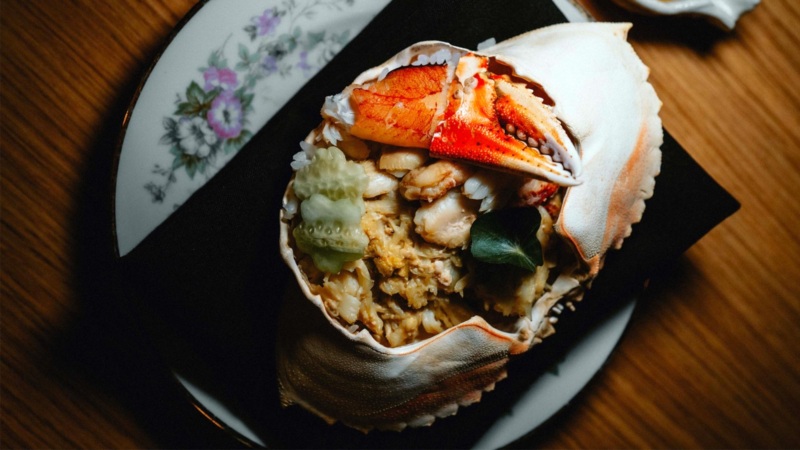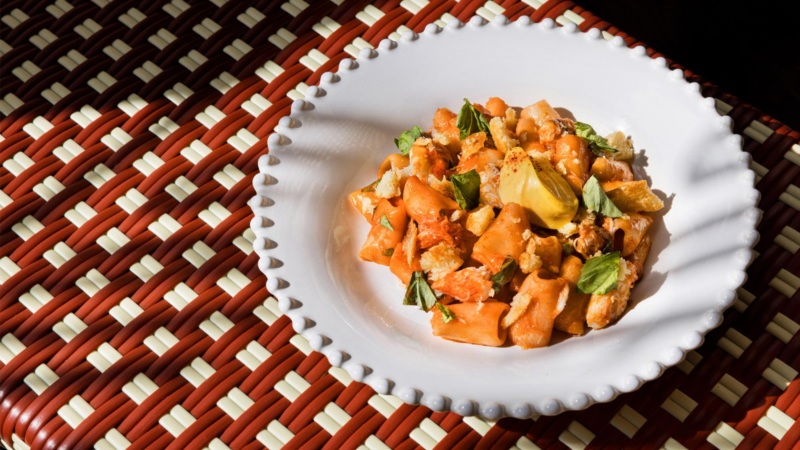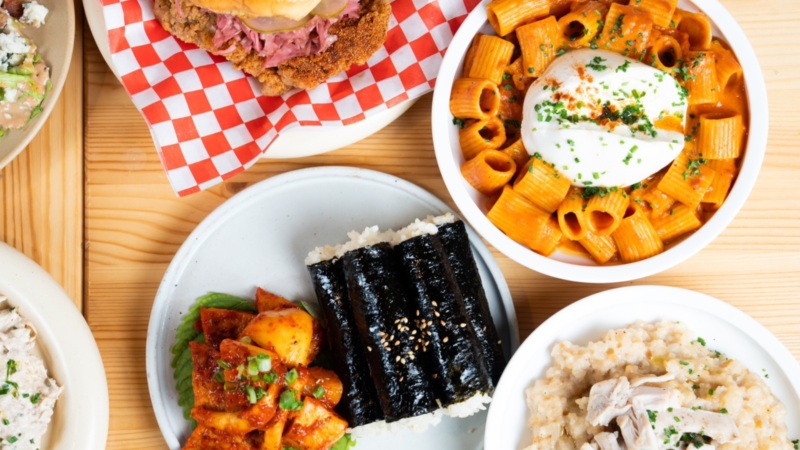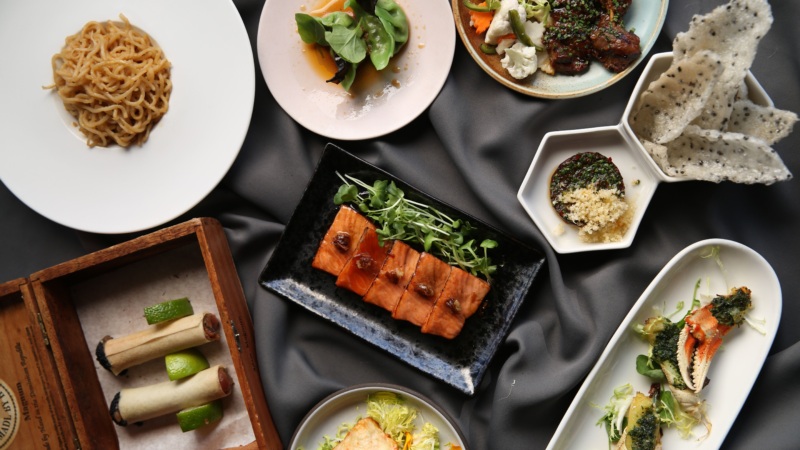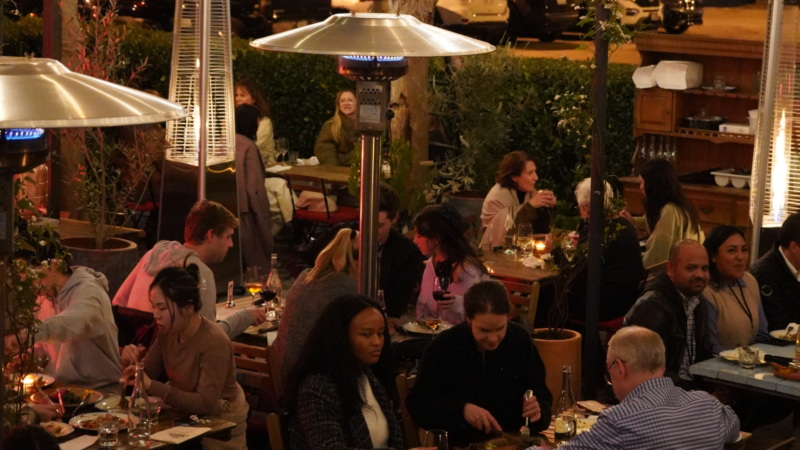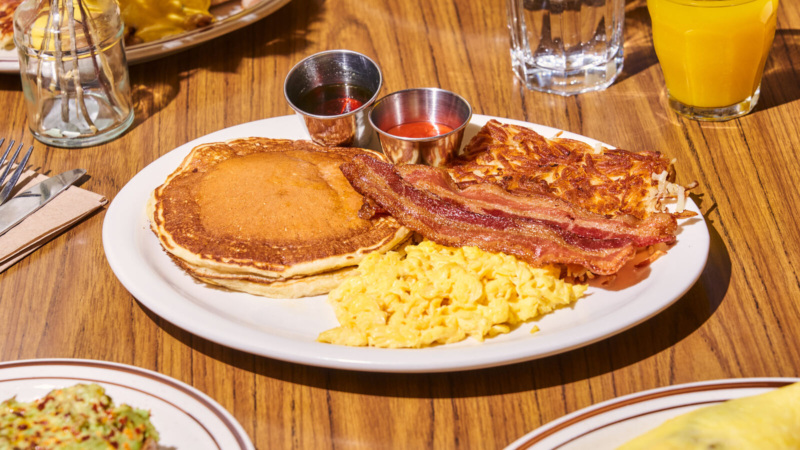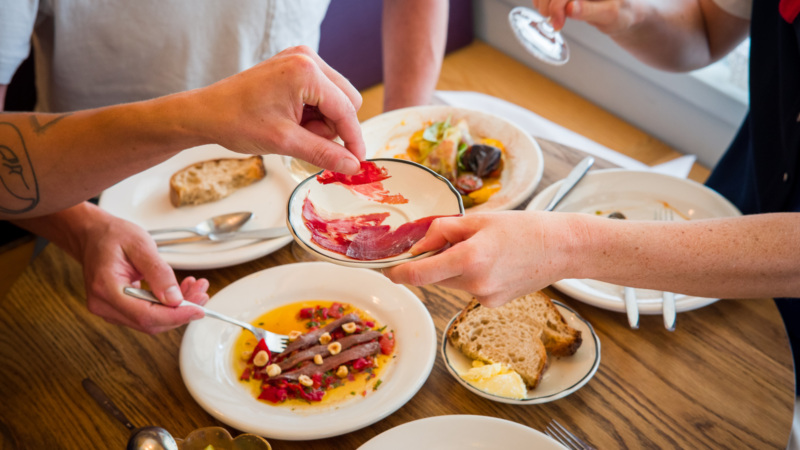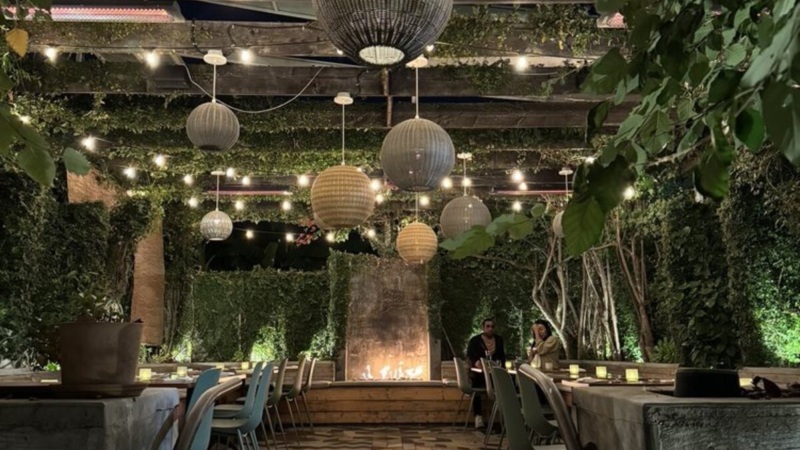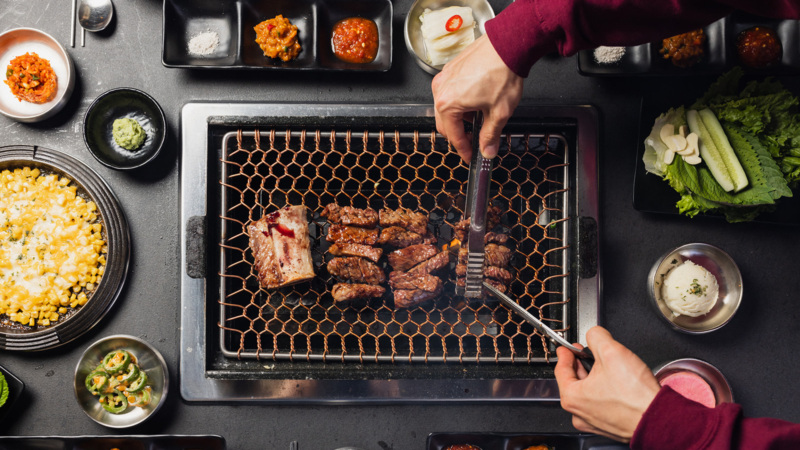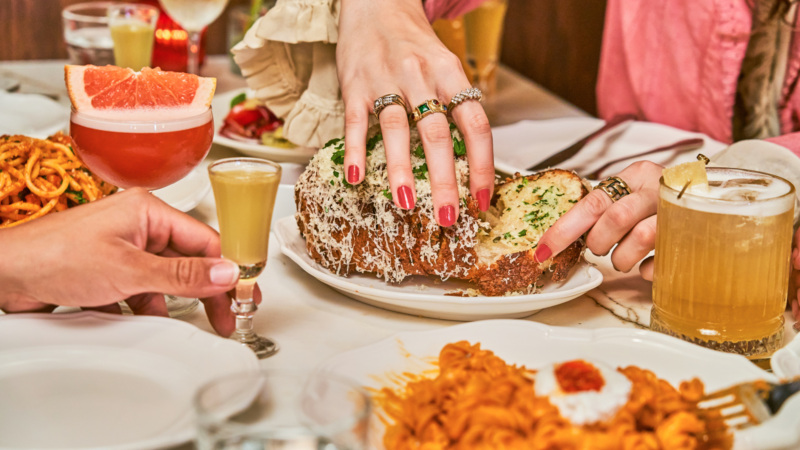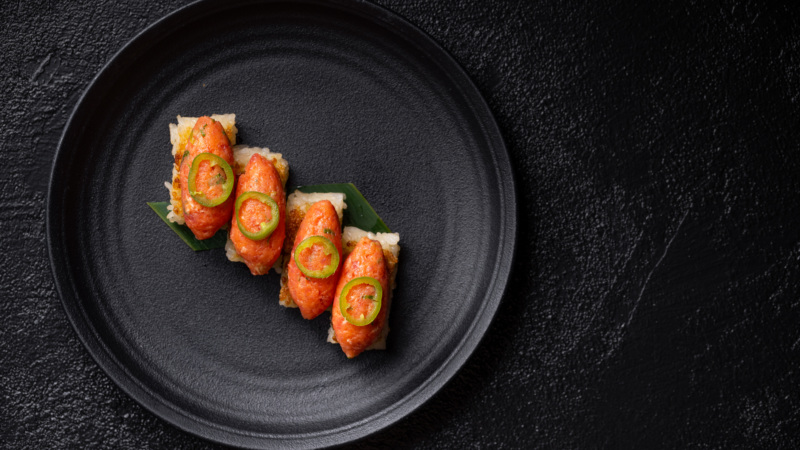
How American Beauty Redefined the Steakhouse, L.A.-Style
It’s a breezy Saturday night in Venice, and the patio at American Beauty is packed. Diners crowd into the outdoor space, sprawling across the wood-slatted booths and pastel pink and green chairs over sand-hued gravel. Soul and old-school hip hop blasts from the speakers.
American Beauty, which opened in 2019 with a laid-back, beachy vibe, is not your typical steakhouse. The restaurant, which also has a moody cocktail bar that opens out into the patio, has just six steak options, all smoked over almond wood, alongside wood-grilled flatbreads with smoked honey and labneh, roasted carrots resting over garlic yogurt and pickled cherries, and a can of Tecate.
Flanking American Beauty is its sister concept: a walk-up burger window aptly named The Win~Dow. Here, trendy smashburgers are $3.95 and grain bowls are $7. The Win~Dow became such a hit at its original Rose Avenue location that its owners, American Gonzo Food Corp. (the parent restaurant group that also owns Pitfire Pizza and Superba), opened two more, equally popular locations, on the Venice Boardwalk and in Silver Lake.
Much of this growth took place amid the pandemic, while the company attempted to figure out its strengths during a turbulent time. We spoke to chef and culinary director Elisha Ben-Haim and CEO Jeff Goodman about how they’re creating their own version of a modern neighborhood steakhouse, how the pandemic transformed their business, and the secret sauce to their success.
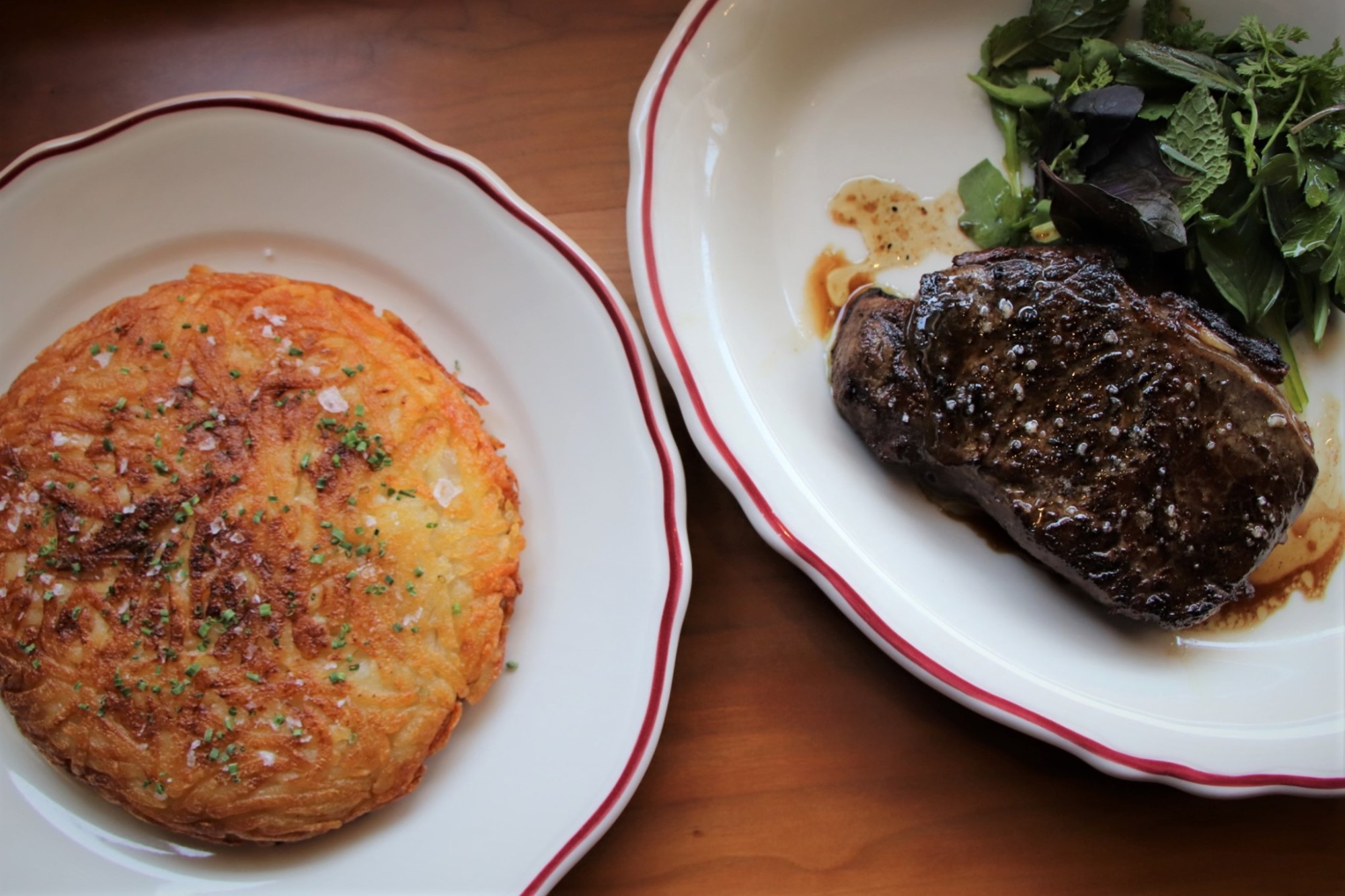
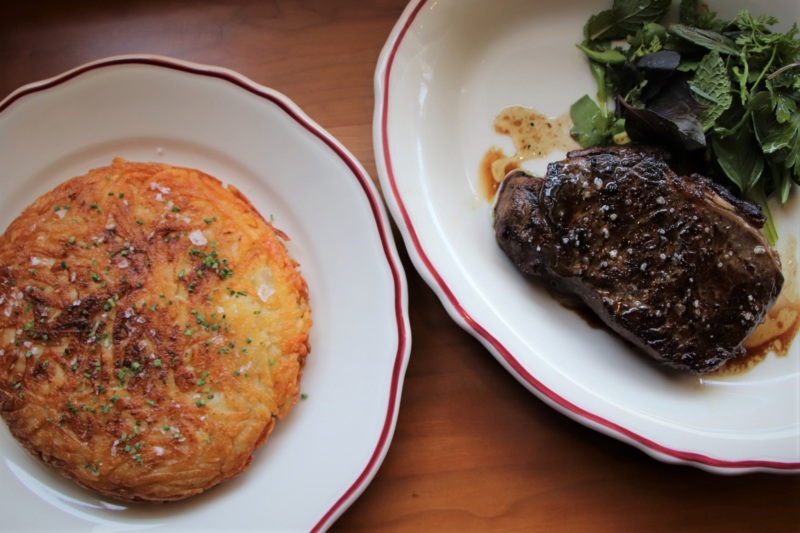
What does it mean to be a Venice steakhouse?
Jeff Goodman: Our ambition is to be a steakhouse that reflects how people want to eat now. We have a lot of love and respect for the conventions of the genre: There’s great meat, fun sides, big beverage programs, good martinis, and great service. All those things are important to our archetype, but the days of eating a 20-ounce boneless New York strip, half-pound of shrimp cocktail, two martinis, a magnum of wine, and then going home and having a three-day food coma are dead. That’s not how people like to eat anymore. What people want is better food, with better techniques, better curation, and fewer but better choices with a more appropriate portion size.
Elisha Ben-Haim: There’s also an element to the classic steakhouse that gives nostalgia and some comfort to a certain audience — people that might be a little bit older, who are used to business dinners and whatnot. We wanted to be more inclusive and try to make it approachable for the younger people in our neighborhood. We do this through our design, menu, and price points. We looked at all these different factors and tried to find the sweet spot in a small kitchen that’s very busy.
Jeff Goodman: Our design is — with a hat tip to classic steakhouse design — anything but classic. Our design partner, formerly known as David Irwin, but now Shin Irvin, who runs Folklor, is really just a brilliant guy and eclectic thinker. Every every part of what our steakhouse is speaks to Venice. It was formerly a ranch market — a Mexican market with a taqueria — and as an honorific to its origin, we left the outside of the restaurant as is. We were really trying to create some surprise and delight as you’re walking through the door.
At American Beauty, you have 15- and 30-day dry-aged steaks from Flannery Beef. How did using dry-aged steaks and smoking over almond wood become part of your process?
Elisha Ben-Haim: Dry-aging steak and meats for that enhanced beefy flavor is a very American tradition that we knew we wanted to feature as part of our menu. During my career in New York (working in the kitchens of Le Bernardin, Alto, and Toro), it was very popular to grill over gas, mostly because of permitting and how kitchens are set up in the buildings there. In Los Angeles, cooking over wood fire is much more common. It’s a method that skips over the more modern cooking techniques of the last 20 years and gets back to the basics of cooking — back to caveman days. That wood fire also enhances a steak’s flavor, adding a blue-cheese quality and again boosting the beefiness.
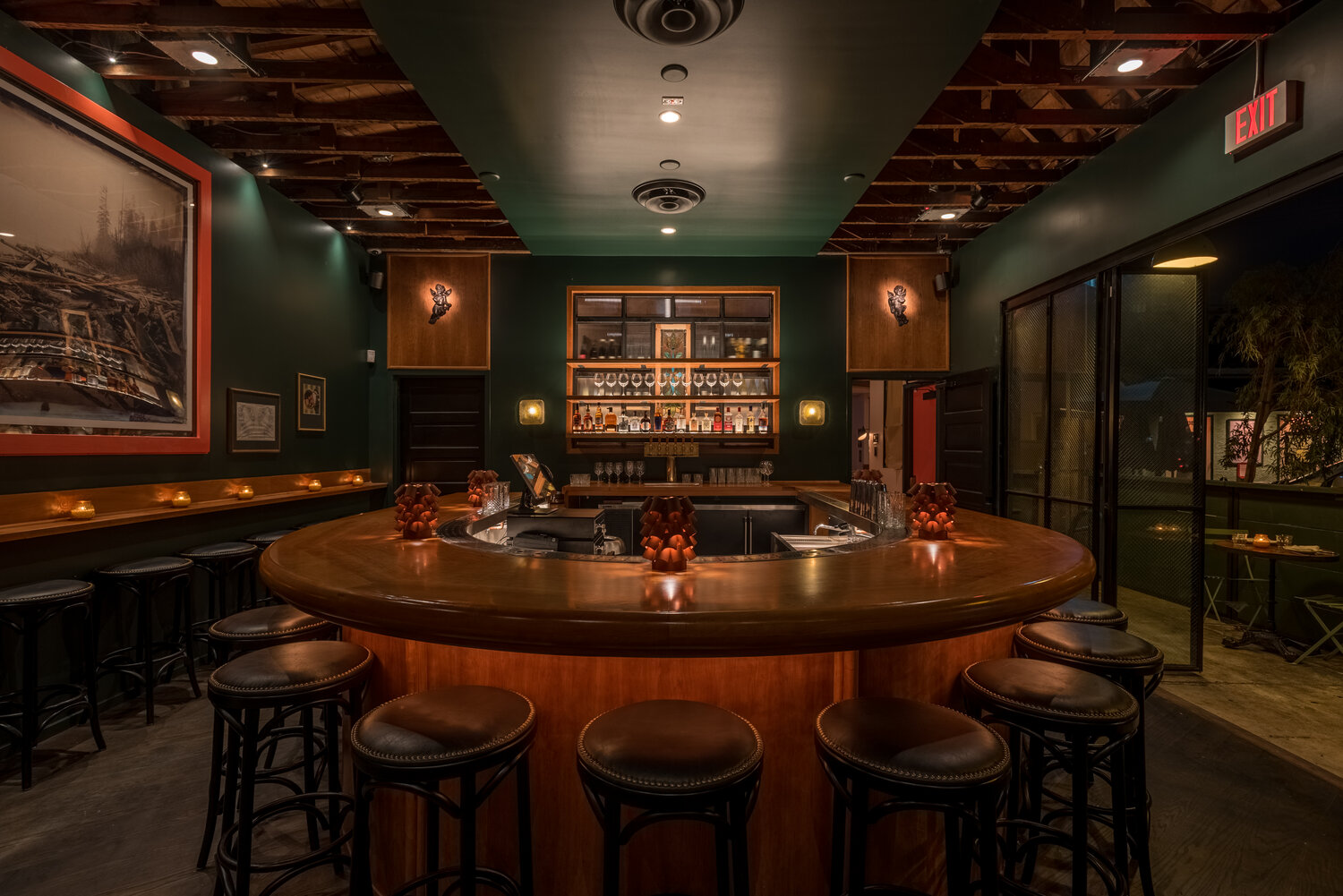

What makes your steaks stand out?
Elisha Ben-Haim: We have six steaks. Some people say, “What kind of steakhouse only has six steaks?” But we made sure every one of our steaks hits a certain criteria, quality, and price point, with a different kind of cut, content, or texture.
The rib eye and porterhouse are highly marbled and dry-aged for the serious steak eaters. Our filet is more about tenderness and is a great choice if your appetite is smaller. We offer an incredible grass-fed New York strip; the beef is finished on carrots to enhance the marbling and flavor. Our hanger and teres major are more esoteric cuts meant to deliver a delicious experience with great value.
How do the other dishes stand up to the steaks?
Elisha Ben-Haim: In a classic steakhouse, it’s about the meat and everything else plays second fiddle. We look at it as “Okay, you can come in and have that experience [if you want it].” But I think for me, one of the bigger elements of pride is that you can come to American Beauty as a vegetarian and have a great experience.
Jeff Goodman: The maitake mushrooms might be the most underrated dish in Venice right now. The prawns are ridiculously good. His take on a chopped salad with a spicy vinaigrette is killer. While most steakhouses aren’t known for desserts, we’re blessed with Elisha as a chef who actually has a savant talent with sweets. Before it was a trend, he did a burnt cheesecake that I would put against any Basque cheesecake in L.A. He did a strawberry shortcake in the spring that he transitioned to a peaches and cream stone fruit shortcake for summer that’s exceptional. We’re doing this throwback to 1999 molten chocolate cake that’s got a molten peanut butter core, come on!
We want as many things as possible to be touched by the live fire. We want the seafood, the veggies, the poultry to be as good — if not better — than the steaks. But another really important theme is this high-low dynamic that we’ve achieved. We want the restaurant to be egalitarian. We want anyone who’s interested in trying out American Beauty to feel comfortable coming in.
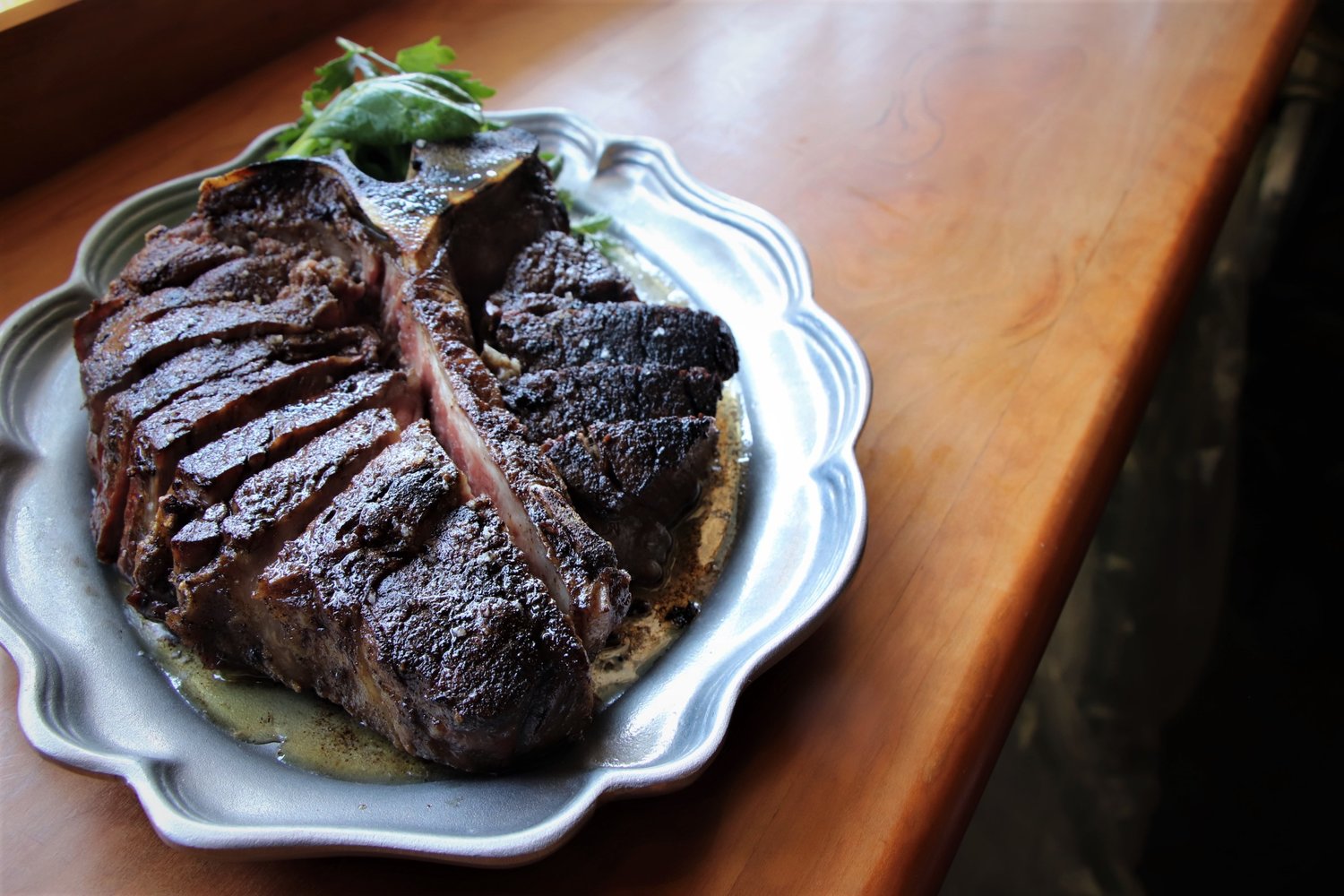
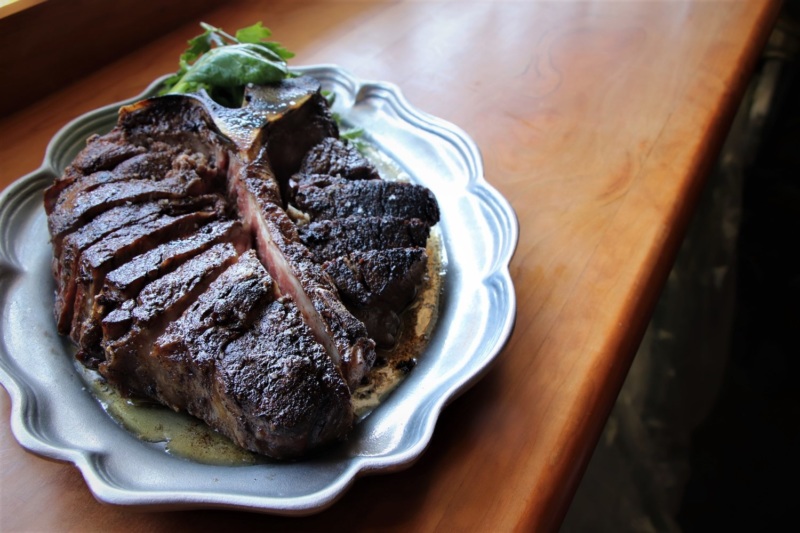
In what ways do you try to make it egalitarian?
Jeff Goodman: A single burger at The Win~Dow is $3.95. There’s nowhere else in Venice that is serving a burger — let alone our quality of burger — at that price. And that’s very deliberate. We have a teres major steak on the menu at $25. We’ve always had — I say it affectionately — a “cheap steak” on the menu. We have a $3 can of Tecate and a $10 glass of house wine that’s poured to the very tippy top of the glass on our beverage menu. If someone wants to come into American Beauty and have a $30 experience and just have a great time and be amongst the people, we want to deliver that. And if they want to drink $500 bottles of Barolo and a $160 30-day, dry-aged porterhouse, we want them to do that as well.
When we had a parking lot (before it became our outdoor dining patio), you saw that in action every night. I would sit in the parking lot for a little while and watch what everyone was doing and who was coming in. And there would be a Bentley, Tesla, beater, surf bike, scooter, skateboard — people were showing up from all walks of life. Some people showed up in shorts and others showed up classy. But that very much is a reflection of our desire to be for everyone, and of Venice itself.
How did the parking lot transform into the outdoor dining patio?
Jeff Goodman: The whole outdoor area is a post-COVID move. We opened The Win~Dow in March of 2019, and then we opened American Beauty in late September of 2019. We only had a short run indoors. When the pandemic struck in March of 2020, we paused the steakhouse and expanded the hours of The Win~Dow. And as we realized that the pandemic was going to last a while, we turned the parking lot into the patio you see now.
We partnered with Heather Tierney, who is a friend of our company’s and owns De Buena Planta and Butcher’s Daughter, to design the patio. We dropped 30 tons of gravel, built the fencing, built a deck off the bar, installed a 25-foot olive tree, built millwork around the olive tree, and put in the fire pits.
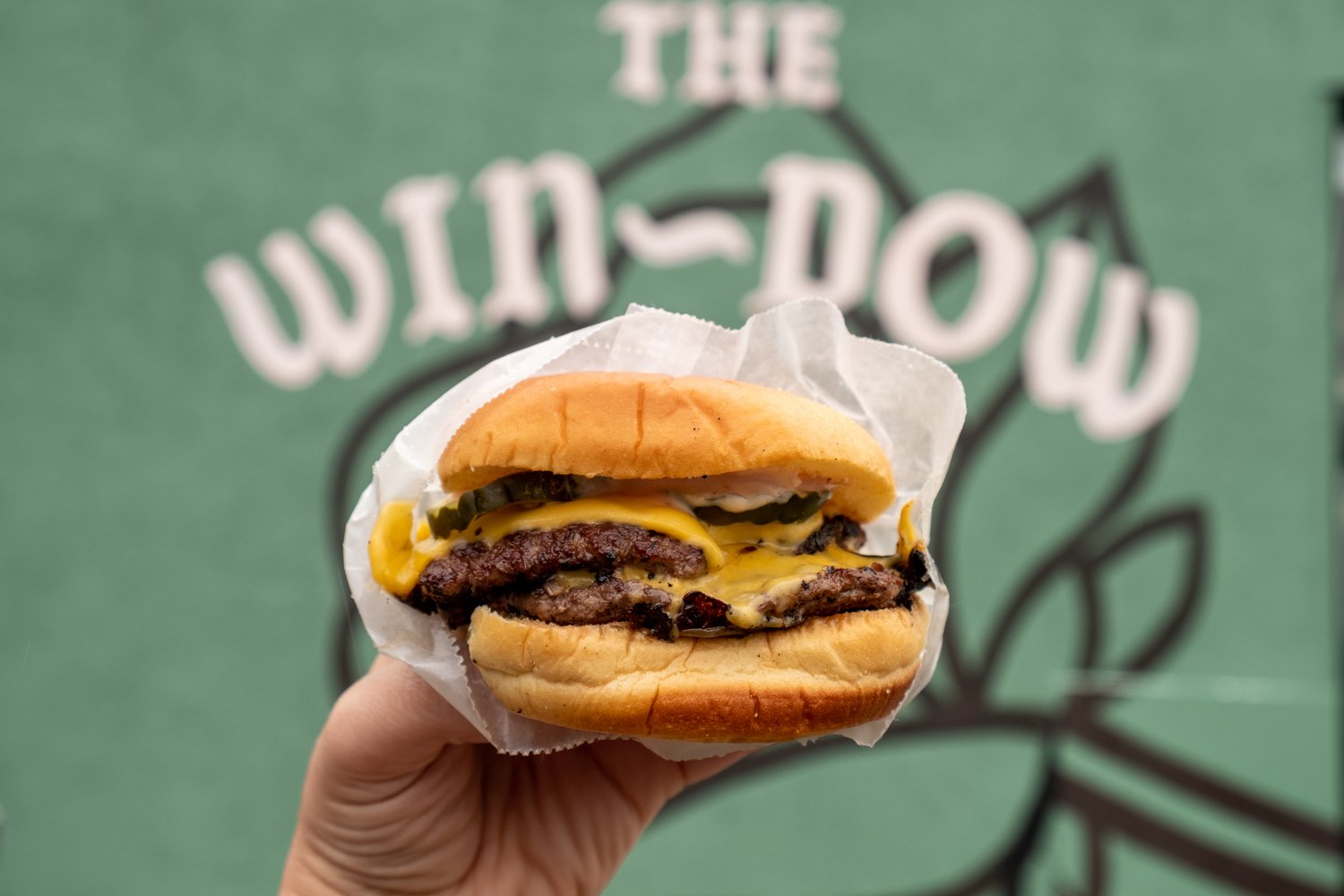
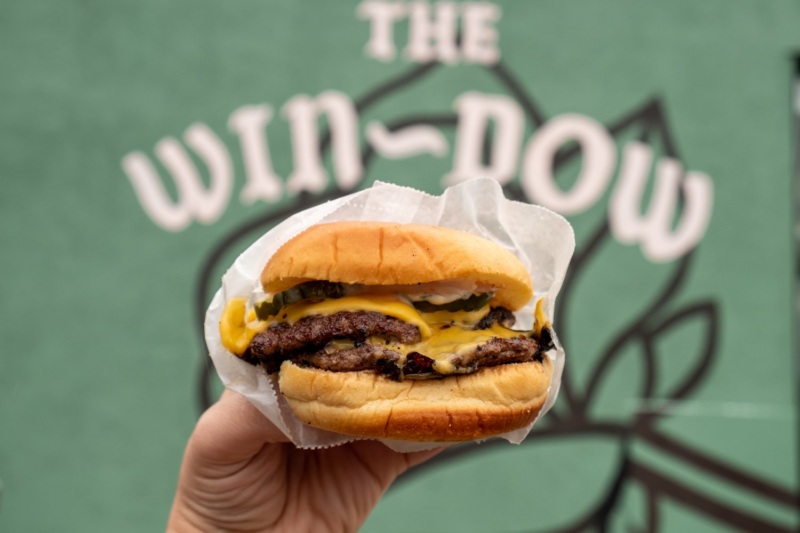
How did the concept for The Win~Dow form?
Jeff Goodman: American Beauty is small: It’s 3,000 square feet. We knew that we wouldn’t be able to have a full-service lunch and dinner, but we wanted to do something for lunch. We wanted it to be slightly next-generation fast food.
The burgers are very chef- and product-driven, but we also included a fried chicken sandwich, which was pre-trend at that point, and a grain bowl that is 100% Elisha’s. It’s very much in line with how he thinks about food. It’s an odd but perfect menu that’s Venice-style fast food. But really, the driving force behind it was doing something that made sense in the space and doing something that anyone in the community could use every day if they wanted to. The per person average is $11.
Did The Win~Dow also come about because you feel Californians just love smashburgers?
Jeff Goodman: Everyone loves burgers. But we’d like to believe we had one of the first smashburgers in town. I’d like to say it was maybe pre-California’s love affair with smashburgers.
What’s on the horizon for these restaurants?
Jeff Goodman: We’re not prepared to announce them yet, but there will be a handful of Win~Dows and an American Beauty opening next year.
And finally, how did the name “American Beauty” come about?
Jeff Goodman: We really liked that “American Beauty” is a poetic name with a lot of interpretations, from a type of rose to a Grateful Dead album. We’ll leave it up to our guests to decide what it means to them.
Jean Trinh’s food and culture stories have appeared in The Washington Post, Los Angeles Times, and Food & Wine. Follow her on Twitter and Instagram. Follow Resy, too.


